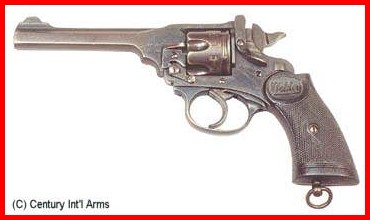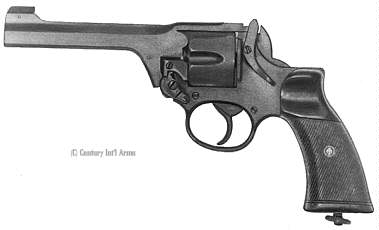 |
 |
 |
presents
HISTORIC FIREARM OF THE MONTH, JULY 1999:
 |
 |
 |
| Type: Double Action Hinged Frame Revolver
Extraction: Automatic upon opening Caliber: .38/145/200 (.38 S&W) Capacity: 6 rounds Sights: Fixed front and rear |
 |
The Webley
& Scott Mk.VI revolver, caliber .455, was the standard British service
revolver during and immediately following the First World War. It
was produced by Webley & Scott of Birmingham (who had been producing
Britain's service sidearms since 1887) until 1921, when production of the
Mk. VI was undertaken by the Royal Small Arms Factory (RSAF) at Enfield
Lock. This government production continued until 1926.
Webley & Scott submitted a sample .380 revolver to the War Office on July 19th, 1921, along with 200 rounds of modified .38 Smith & Wesson (S&W) ammunition. The revolver was a modified Webley Mk. III hinged frame, self-ejecting pocket model. New features included a detachable striker for the hammer and a removable sideplate cover. The ammunition was modified to use lead bullets of over 200 grains in weight.
Based on the War Office's evaluation, a new Mk. IV model was submitted in January, 1922, and received favorable reports from the Army's Small Arms School. The revolver was generally liked for its lighter weight and shorter barrel and it was considered to be a better service weapon than the .455 Mk. VI Webley, provided that a projectile of sufficient stopping power could be provided.
Since the length of the cylinder precluded the use of a longer cartridge, such as the .38 Special, the Kynoch ammunition concern produced a test batch of ammunition that had 200 grain lead bullets propelled by 2.8 grains of "Neonite" nitro-cellulose powder in a case dimensionally identical to the .38 S&W. This load produced a bullet which lost stability after target penetration, yet maintained a velocity in excess of 570 feet per second at 50 yards. This was deemed acceptable, and became the .380/200 service cartridge.
Meanwhile, all was not well at Webley & Scott. The government Small Arms Committee, in Minute 489, dated August 30th, 1922, directed RSAF Enfield to arrange the manufacture of the new revolver. This they did, making no changes to the Webley Mk. IV worthy of note, save the elimination of certain manufacturing features to speed production, and a subtle reshaping of the grip. Webley & Scott was understandably upset by this turn of events - when they were shown the engineering drawings of the RSAF Enfield revolver, no design acknowledgment was given to Webley & Scott!
Despite this, two .380 Webley & Scott Mk. IV revolvers were sent to the Small Arms School in March, 1924, and underwent trials from September 4th to 11th, 1924. These guns, one with a 6 inch barrel and one with a 5 inch barrel achieved 1 inch groups at 10 yards and 2 inch groups at 20 yards.
By 1927, Webley & Scott became aware that their design for the Mk. IV had been pirated by the government as the "Pistol, Revolver, No. 2 Mk. 1," and that there was
| no intention by RSAF Enfield to have the new revolver manufactured by Webley & Scott. Webley & Scott sued the government for their development costs, but were denied. They were eventually awarded about 50% of their claim by the Royal Commission on Awards to Inventors, | 
Enfield No.2 Mk.I* Revolver, Caliber .380/200 |
Webley was to have the last laugh, though. RSAF Enfield was to prove unable to keep up with the demand for pistols caused by the Second World War. As a result, Webley & Scott was to provide over 120,000 Mk. IV, .38 caliber pistols to the British and Commonwealth forces, with the Mk. IV becoming officially approved for British service on September 20th, 1945.
Use of the commercial Webley Mk. IV by many police forces around the globe, notably those in Britain, Israel, Canada, and Australia, continued as late as the 1970's, and in some places continues today, a fine testament to this outstanding revolver.
While British military .380 ammunition is available, the Webley Mk. IV shoots incredibly well with US commercial .38 S&W ammunition. While the point of impact vs. point of aim may vary due to the lighter bullets used in the US commercial ammunition (146 grains as opposed to 178 or 200), group sizes can be astonishingly small. The author shot a 1 1/2" group at 25 yards with a 4" commercial Webley Mk. IV formerly owned by a British police agency.
Bibliography
Dowell,
William Chipcase, The Webley Story, Commonwealth Heritage Foundation
(Kirkland, Washington, 1987)
Stamps, Mark and Ian Skennerton, .380 Enfield No. 2 Revolver, IDSA Books (Piqua, Ohio, 1993)
Both titles are available from I.D.S.A. Books.